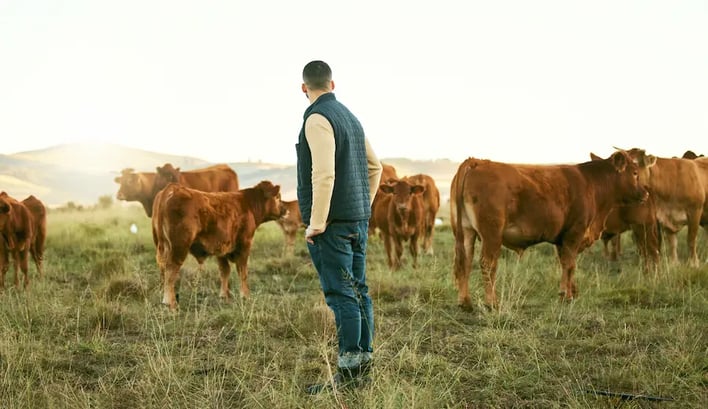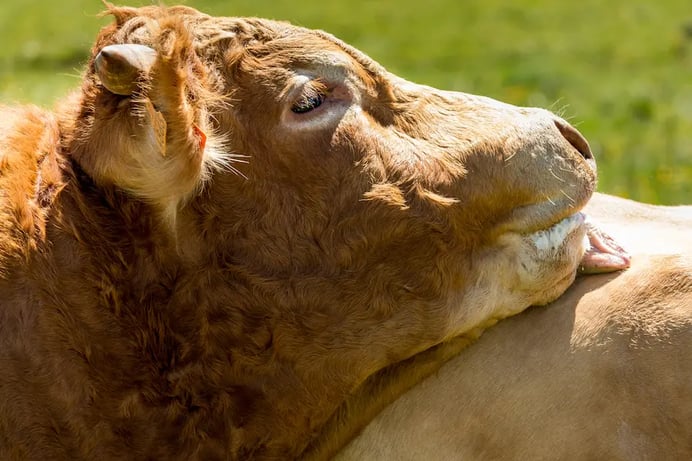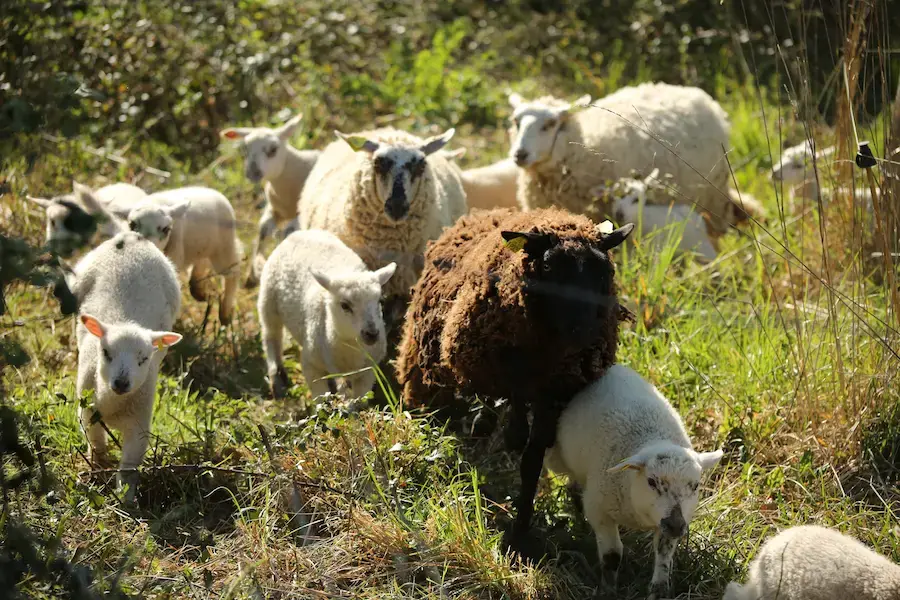Several species of helminths, including gastrointestinal nematodes (GINs), lungworms, and liver flukes, affect ruminants (cattle, sheep, and goats). In grass-based production systems, most herds and flocks are infected by these parasites, with the primary economic impact resulting mainly from subclinical infections that lead to reduced growth and a decrease in meat, milk or whool production. The development of anthelmintic resistance further compounds these challenges, resulting in a significant decrease in revenues.
Prefer to listen to this article? Click the play button below and enjoy our podcast!

Indeed, a recent study of the economic impact of helminth parasitism on the European ruminant livestock industry revealed an annual loss of €1.9 billion, of which 38% were attributable to GIN infections (1). Since anthelmintics are a cornerstone to control these infections, one of the challenges that livestock farming faces today is the decrease of efficacy of these treatments due to the presence of anthelmintic resistance (AR). AR is now widespread among the main GIN species and have been observed in sheep, goats, and cattle herds in many countries.
Factors influencing anthelmintic resistance
The efficacy of modern anthelmintics against susceptible strains is usually above 95%. In the case of helminths, the eggs of parasites that survive treatment are eliminated with the faeces into the environment contaminating pastures, resulting in the development of generations of resistant parasites and, therefore, AR by selection pressure. The rate of AR development is influenced by many factors that can be grouped into three categories: genetic, biological, and management.

Genetic factors relate to the frequency and persistence of resistance-associated genotypes, while biological factors relate to possible changes in the pathogenesis and/or morphology of the parasite depending on whether it is resistant or susceptible. Management factors are considered the most important as they are directly dependent on the farmer and form the basis of resistance management programmes. However, it is necessary to understand the genetic and biological factors to carry out correct management procedures. The factors which should be considered to prevent the occurrence and development of AR are described below.
Treatment frequency
The frequency of treatment is one of the most important factors associated with the development of AR (2-4). AR occurs more rapidly in regions where animals are regularly dewormed. A short interval between treatments can result in a very strong selection pressure on the parasites. The basic principle of AR selection is that treatment gives surviving parasites a reproductive and replication advantage over susceptible parasites for approximately 2 to 3 weeks after anthelmintic administration (4). The administration of prophylactic mass treatments has also contributed to the widespread development of AR (5).
Underdosing
Another important factor is the administration of incorrect anthelmintic doses or underdosing. This is mainly because visual weight estimation is the most commonly used method to calculate the dose of anthelmintic to be administered to animals, which is often inappropriate and can lead to underdosing. Dispensing guns which are not properly calibrated can also lead to underdosing.

Cattle and sheep can sometimes be infected by several species of helminths such as GIN and Fasciola spp. If no coprology is done before deworming, farmers usually assume the presence of GIN only, since these are the most common helminth parasites. However, when using certain anthelmintics, for example albendazole, the therapeutic dose against Fasciola spp is higher than against GIN and therefore there could be a situation of underdosing for Fasciola if the GIN dosing is used (6).
In various situations, the administration of pour-on formulations can lead to underdosing (7,8). The lower efficacy of pour-on drugs may be attributed to climatic factors, low bioavailability or to animals inadvertently ingesting drugs through their contact with treated animals (8,9). In an experiment where only 40% of the herd was treated with a pour-on formulation of ivermectin, it was found that the untreated animals were under-exposed to the substance and shown partial anthelmintic efficacy (7).

Pasture management and treatment timing
The management of pastures and timing of treatment also have a strong influence on the development of AR. It has been a recommended practice for years to administer an anthelmintic and move animals to areas with little or no contamination, known as the "dose and move" system (10). Another common practice is to schedule treatment administration during the dry season to reduce rapid reinfection of animals. However, these management systems exert strong selection pressure and contribute to the development of resistance, as the eggs of parasites that resist treatment contaminate "clean" pastures. In this case the animals will only be infected with resistant parasites, aggravating the problem.
Lack of alternating family of anthelmintics
Another factor that can also contribute to the development of AR is the frequent and continuous use of a single drug without alternating it with another drug from a different chemical family. It is important to note that resistance is developed to drugs in the same family and not to a specific drug (11). This is because the mechanism of action is the same for all drugs belonging to the same family, so it is always advisable to alternate drugs from different families, such as benzimidazoles and macrocyclic lactones.
Introduction of animals infected with resistant parasites
A last way to acquire resistance is the introduction of resistant parasites into the herd or flock through the acquisition of animals from other farms. To avoid the introduction of resistant parasites into the farm, a coprological analysis should be carried out to determine the species of parasites affecting the animal to administer the correct therapeutic dose, considering the recommendations mentioned above. Ideally, new animals should not be introduced into the herd or flock until the effectiveness of the treatment has been confirmed by a second coprological analysis, 10-14 days after treatment.
Recommendations
To slow down the development of resistance, there are some important points to remember:
- Coprological analysis should be performed whenever possible before deworming to confirm the worm burden and parasitic species
- Try to alternate families of anthelmintics in successive treatments and adjust the therapeutic dose correctly can contribute to reduce the development of resistance
- Animals should be correctly weighed prior to treatment to avoid under-dosing; if this is not feasible, the weight of the biggest animals in the herd or flock should be evaluated and used as a reference for the entire herd or flock to avoid under-dosing.
- Restrict the use of pour-on formulations
- Think selective instead of systematic
References
1. Charlier J, Rinaldi L, Musella V, Ploeger HW, Chartier C, Vineer HR, Hinney B, von Samson-Himmelstjerna G, Băcescu B, Mickiewicz M, Mateus TL, Martinez-Valladares M, Quealy S, Azaizeh H, Sekovska B, Akkari H, Petkevicius S, Hektoen L, Höglund J, Morgan ER, Bartley DJ, Claerebout E. Initial assessment of the economic burden of major parasitic helminth infections to the ruminant livestock industry in Europe. Prev Vet Med. 2020 Sep;182:105103.
2. Morgan ER, Coles GC. Nematode control practices on sheep farms following an information campaign aiming to delay anthelmintic resistance. Vet Rec. 2010 Mar 6;166(10):301-3.
3. Cabaret J, Benoit M, Laignel G, Nicourt C. Current management of farms and internal parasites by conventional and organic meat sheep French farmers and acceptance of targeted selective treatments. Vet Parasitol. 2009 Sep 16;164(1):21-9.
4. Falzon LC, O'Neill TJ, Menzies PI, Peregrine AS, Jones-Bitton A, vanLeeuwen J, Mederos A. A systematic review and meta-analysis of factors associated with anthelmintic resistance in sheep. Prev Vet Med. 2014 Nov 15;117(2):388-402.
5. Fissiha W, Kinde MZ. Anthelmintic Resistance and Its Mechanism: A Review. Infect Drug Resist. 2021 Dec 15;14:5403-5410.
6. Beesley NJ, Caminade C, Charlier J, Flynn RJ, Hodgkinson JE, Martinez-Moreno A, Martinez-Valladares M, Perez J, Rinaldi L, Williams DJL. Fasciola and fasciolosis in ruminants in Europe: Identifying research needs. Transbound Emerg Dis. 2018 May;65 Suppl 1(Suppl 1):199-216.
7. Bousquet-Mélou A, Jacquiet P, Hoste H, et al. Licking behaviour induces partial anthelmintic efficacy of ivermectin pour-on formulation in untreated cattle. Int J Parasitol. 2011;41(5):563-569.
8. Jouffroy S, Bordes L, Grisez C, et al. First report of eprinomectin-resistant isolates of Haemonchus contortus in 5 dairy sheep farms from the Pyrénées Atlantiques département in France [published online ahead of print, 2023 Jan 20]. Parasitology. 2023;150(4):1-9.
9. Sargent RM, Chambers M, Elliott T. Seasonal differences in the efficacy of pour-on formulations of triclabendazole and ivermectin or abamectin against late immature liver fluke (Fasciola hepatica) in cattle. Vet Parasitol. 2009 Apr 6;161(1-2):133-7.
10. Höglund J, Gustafsson K. Anthelmintic Treatment of Sheep and the Role of Parasites Refugia in a Local Context. Animals (Basel). 2023 Jun 12;13(12):1960.
11. Morgan ER, Aziz NA, Blanchard A, Charlier J, Charvet C, Claerebout E, Geldhof P, Greer AW, Hertzberg H, Hodgkinson J, Höglund J, Hoste H, Kaplan RM, Martínez-Valladares M, Mitchell S, Ploeger HW, Rinaldi L, von Samson-Himmelstjerna G, Sotiraki S, Schnyder M, Skuce P, Bartley D, Kenyon F, Thamsborg SM, Vineer HR, de Waal T, Williams AR, van Wyk JA, Vercruysse J. 100 Questions in Livestock Helminthology Research. Trends Parasitol. 2019 Jan;35(1):52-71.
About the author
María Martínez Valladares (Senior Scientist at CSIC)
María Martínez Valladares has a degree and PhD in Veterinary Medicine from the University of Leon, Spain, and currently, she is a Senior Scientist at Spanish National Research Council (CSIC) in the Mountain Livestock Institute. She is a member of the research group ENTROPIA (Tropical and Parasitic Diseases), leading the research on helminth parasites. She also belongs to the European network LiHRA, “Livestock Helminth Research Alliance” https://www.lihra.eu/. In 2019, she received the "Peter Nansen Young Scientist Award" by the "World Association for the Advancement of Veterinary Parasitology", a recognition to the best young researcher. In 2020 she was awarded as Full Member of the “Spanish Young Academy”, being the only veterinarian among all members.
Explore author’s articlesAbout the author
Damien Achard (Ruminants Global Technical Manager)
Seasoned veterinarian, graduated from Ecole Nationale Vétérinaire de Nantes (France). After three years as a practitioner in central France, he pursued specialization in large animal internal medicine, completing an ACVIM residency and a Master of Sciences at the University of Montréal (2010-2014). Joining Semex Alliance as Health Manager for an IVF unit (2015-2016), he then transitioned to Ceva in 2016 as a Ruminants Global Technical Manager. Dr. Achard is an accomplished researcher, publishing on topics like downer cows, calf pneumonia or cryptosporidiosis and their associated therapies, and rational use of anthelmintics in ruminants. His ResearchGate profile (https://www.researchgate.net/profile/Damien-Achard/research) highlights his significant contributions to the veterinary field.




Leave your comments here